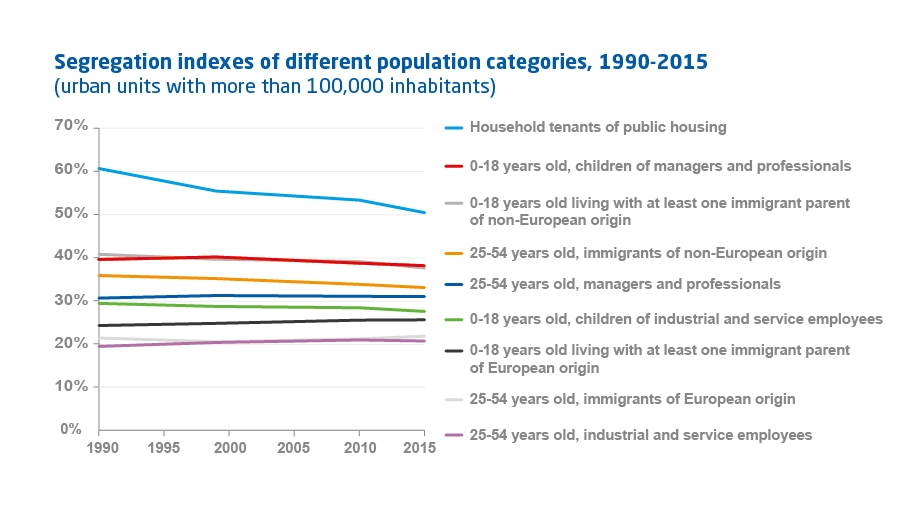
This note examines the fifty-five “urban units” in metropolitan France with more than 100,000 inhabitants between 1990 and 2015 based on census data. A specially designed visualization tool enables these urban units to be compared –among themselves and over time – with all their specific features, and for different categories of population [1].
First, managers and professionals are one and a half times more unevenly distributed than industrial and service employees. In the Paris conurbation, this residential segregation has increased for both groups. Elsewhere, it has decreased on average for managers and professionals, but remained stable for industrial
and service employees. Fewer of the latter live in a neighborhood, where they represent the majority of the 25-54-year-olds (one out of two in 1990, one out of three in 2015). By contrast, a growing proportion of managers and professionals live in neighborhoods where they represent the majority of the 25-54-year-olds (0.1 percent in 1990, 14% in 2015). The wealthiest 10% households, moreover, are distributed as unevenly as the poorest 10%, except in Paris, where the richest are particularly segregated.
Immigrants of European origin have a low and stable segregation index over time. Those of non-European origin, and especially their children, are much more segregated, though less so in 2015 than in 1990. Because their numbers have increased, children living with at least one immigrant parent from outside Europe are more likely to live in neighborhoods where they make up the majority of the under-18s (38% in 2015, compared with 17% in 1990). But those living with two non-European immigrant parents – whose share is stable over time – rarely, and less often, live in neighborhoods where they make up the majority of the under-18s (4% in 2015, compared with 10% in 1990).
Finally, public housing appears less unevenly distributed over the territory in 2015 than in 1990, with a segregation index that has dropped by ten percentage points on average. Yet the impact of public housing on residential segregation is uncertain: public housing has become slightly less concentrated in certain neighborhood, while remaining unevenly distributed, and is home for a growing proportion of industrial and service employees and immigrants.

Read the full document in french
[1] This tool is available online. See also the working paper: Botton H., Cusset P.-Y., Dherbécourt C. and George A. (2020), "L'évolution de la ségrégation résidentielle en France: 1990-2015", Working Paper, No. 2020-09, France Stratégie, July.









